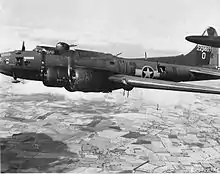364th Bombardment Squadron
The 364th Bombardment Squadron is an inactive United States Air Force unit. It was last assigned to the 305th Bombardment Wing at Bunker Hill Air Force Base, Indiana.
| 364th Bombardment Squadron | |
|---|---|
._Photo_taken_on_June_29%252C_1967_061101-F-1234P-019.jpg.webp) B-58A Hustler, last plane flown by the squadron[note 1] | |
| Active | 1942–1946; 1947–1948; 1951–1970 |
| Country | |
| Branch | |
| Role | medium bomber |
| Engagements | European Theater of Operations[1] |
| Decorations | Distinguished Unit Citation Air Force Outstanding Unit Award[1] |
| Insignia | |
| 364th Bombardment Squadron emblem (approved 18 October 1944)[1] |  |

History
World War II
The squadron was established in June 1942 as a B-17 Flying Fortress heavy bombardment unit; it trained as part of the Second Air Force. It was deployed to the European Theater of Operations (ETO) in September 1942, being assigned to VIII Bomber Command in England. The unit began flying long-range strategic bombardment missions on 17 November 1942 and attacked such targets as submarine pens, docks, harbours, shipyards, motor works and marshalling yards in France, Germany and the Low Countries. The squadron continued its attacks on enemy cities, manufacturing centers, transportation links and other targets until the German Capitulation in May 1945.
After combat missions ended, it moved to St Trond Air Base in Belgium in July 1945 where it conducted photo-mapping and intelligence-gathering flights called Project 'Casey Jones' over Europe and North Africa. On 15 December 1945 the squadron moved to Lechfeld Airfield, Germany which it had bombed on 18 March 1944 and now used as an occupation base.
The 364th Bomb Squadron was inactivated on December 1946 in Germany.
Strategic Air Command
Reactivated under Strategic Air Command (SAC) in 1951 with B-47A (later B) Stratojet medium jet bombers, it began flying operational strategic bombardment and refueling missions from MacDill AFB, Florida. In 1955, SAC upgraded the squadron to the B-47E, the major production version of the Stratojet. The squadron, with B-47s, was reassigned to Bunker Hill AFB, Indiana in May 1959 and in September 1960, it was upgraded to the B-58 Hustler supersonic medium bomber; it was declared operationally ready in August 1962. The squadron began phasing down B-58 operations in 1969, before being inactivated in 1970.
Lineage
- Constituted as the 364th Bombardment Squadron (Heavy) on 28 June 1942
- Activated on 1 March 1942
- Redesignated 364th Bombardment Squadron, Heavy on 20 August 1943
- Inactivated on 29 June 1946
- Redesignated 364th Bombardment Squadron, Very Heavy on 11 June 1947
- Activated on 1 July 1947
- Inactivated on 6 September 1948
- Redesignated 364th Bombardment Squadron, Medium on 20 December 1950
- Activated on 2 January 1951[2]
- Inactivated on 1 January 1970
Assignments
- 305th Bombardment Group, 1 March 1942 – 29 June 1946
- 305th Bombardment Group, 1 July 1947 – 6 September 1948
- 305th Bombardment Group, 2 January 1951 (attached to 305th Bombardment Wing after 14 February 1951)
- 305th Bombardment Wing, 16 June 1952 – 1 January 1970[2]
Stations
|
|
Aircraft
- Boeing B-17 Flying Fortress, 1942–1946
- Douglas B-18 Bolo, 1942
- Consolidated B-24 Liberator, 1942
- Boeing B-29 Superfortress, 1951
- Boeing B-47 Stratojet, 1952–1960
- Convair B-58 Hustler, 1960–1970[2]
References
Notes
- Explanatory notes
- Aircraft is Convair B-58A Hustler, serial 59-2442. Photo taken on June 29, 1967
- Aircraft is Boeing B-17F-70-BO Flying Fortress, "Lady Liberty", serial 42-29807. Originally assigned to the 334th Bombardment Squadron and named "Patsy Ann III"
- Despite the similar name, this squadron is not related to the Bombardment Squadron, Provisional, 364th, which was designated and organized at Anderson Air Force Base, Guam on 1 June 1972 and assigned to the Strategic Wing, Provisional, 72d and moved to U-Tapao Royal Thai Navy Airfield, Thailand on 1 July, where it was attached to the 307th Strategic Wing. This unit served to manage Boeing B-52 Stratofortress crews on temporary duty at U Tapao, flying Operation Arc Light combat missions over Indochina until 15 August 1973 when combat missions ended. It continued training operations until stand down 30 June 1974, when it was discontinued.
- Citations
- Maurer, Combat Squadrons, pp. 450-451
- Lineage information, including assignments and aircraft, through March 1963 in Maurer, Combat Squadrons, pp. 450-451.
- Station umber in Anderson.
- Station number in johnson.
- Station information through March 1963 in Maurer, Combat Squadrons, pp. 450-451, except as noted.
Bibliography
![]() This article incorporates public domain material from the Air Force Historical Research Agency website http://www.afhra.af.mil/.
This article incorporates public domain material from the Air Force Historical Research Agency website http://www.afhra.af.mil/.
- Anderson, Capt. Barry (1985). Army Air Forces Stations: A Guide to the Stations Where U.S. Army Air Forces Personnel Served in the United Kingdom During World War II (PDF). Maxwell AFB, AL: Research Division, USAF Historical Research Center. Archived from the original (PDF) on 23 January 2016. Retrieved 28 June 2017.
- Johnson, 1st Lt. David C. (1988). U.S. Army Air Forces Continental Airfields (ETO) D-Day to V-E Day (PDF). Maxwell AFB, AL: Research Division, USAF Historical Research Center. Archived from the original (PDF) on 29 September 2015. Retrieved 26 June 2017.
- Maurer, Maurer, ed. (1983) [1961]. Air Force Combat Units of World War II (PDF) (reprint ed.). Washington, DC: Office of Air Force History. ISBN 0-912799-02-1. LCCN 61060979. Retrieved 17 December 2016.
- Maurer, Maurer, ed. (1982) [1969]. Combat Squadrons of the Air Force, World War II (PDF) (reprint ed.). Washington, DC: Office of Air Force History. ISBN 0-405-12194-6. LCCN 70605402. OCLC 72556.
- Ravenstein, Charles A. (1984). Air Force Combat Wings, Lineage & Honors Histories 1947-1977 (PDF). Washington, DC: Office of Air Force History. ISBN 0-912799-12-9. Retrieved 17 December 2016.
